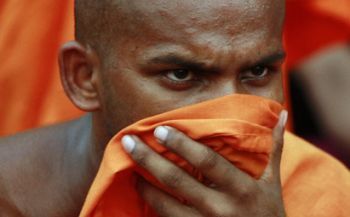
Publisher:
Bonnie King
CONTACT:
Newsroom@Salem-news.com
Advertising:
Adsales@Salem-news.com

~Truth~
~Justice~
~Peace~
TJP
Aug-04-2012 16:16

 TweetFollow @OregonNews
TweetFollow @OregonNews
Buddhists Behaving Badly
William McGowan Special to Salem-News.comWhat Zealotry is Doing to Sri Lanka
 A Buddhist monk protesting in Colombo, 2010. (Andrew Caballero-Reynolds / Courtesy Reuters) |
(WASHINGTON DC) - In Sri Lanka last September, a Sinhalese mob led by some 100 Buddhist monks demolished a Muslim shrine in the ancient city of Anuradhapura. As the crowd waved Buddhist colors, gold and red, a monk set a green Muslim flag on fire. The monks claimed that the shrine was on land that had been given to the Sinhalese 2,000 years ago -- an allusion to their proprietary right over the entire island nation, as inscribed in ancient religious texts.
The Anuradhapura attack was not the only recent incident of Buddhists behaving badly in Sri Lanka. In April, monks led nearly 2,000 Sinhalese Buddhists in a march against a mosque in Dambulla, a holy city where Sinhalese kings are believed to have taken refuge from southern Indian invaders in a vast network of caves almost two millennia ago. The highly charged -- but largely symbolic -- attack marked a "historic day," a monk who led the assault told the crowd, "a victory for those who love the [Sinhala] race, have Sinhala blood, and are Buddhists."
Such chauvinism is at odds with Western preconceptions of Buddhism -- a religion that emphasizes nonviolence and nonattachment -- but is in keeping with Sri Lanka's religious history. Militant Buddhism there has its roots in an ancient narrative called the Mahavamsa (Great Chronicle), which was composed by monks in the sixth century. According to the Mahavamsa, the Buddha foresaw the demise of Buddhism in India but saw a bright future for it in Sri Lanka. "In Lanka, O Lord of Gods, shall my religion be established and flourish," he said. The Sinhalese take this as a sign that they are the Buddha's chosen people, commanded to "preserve and protect" Buddhism in its most pristine form. According to myth, a young Sinhalese prince in the second century BC armed himself with a spear tipped with a relic of the Buddha and led a column of 500 monks to vanquish Tamil invaders. In addition to defending his kingdom from mortal peril, the prince's victory legitimized religious violence as a means for national survival.
Militant Buddhism was a driving force behind the 25-year war between the majority Sinhalese (74 percent of the population) and the minority Tamils (18 percent), who were fighting for an independent state in the island's north and east. (Muslims, who make up six percent of Sri Lanka's population, were often caught in the middle.) During the war, monks repeatedly undercut efforts to work out a peace agreement.
The sangha, as the clergy is collectively referred to in Theravada Buddhism, has historically exercised political power from behind the scenes, embodying a broad form of religious nationalism. But in the later years of the war, it became more overtly politicized. In 2004, the hard-line National Heritage Party (known as the JHU) elected seven of its members to Parliament; all were monks, and the party ran on a platform calling for a return to Buddhist morality in public life. Soon after being seated, the JHU staged an intramural brawl on the floor of Parliament.
The JHU also worked to scuttle a March 2002 Norwegian-brokered peace settlement that called for limited Tamil autonomy. Monks declared that Sri Lanka had always been a Sinhalese kingdom, that autonomy violated the near-mystical idea of a unitary state, and that there was no option other than a military one. Peace negotiations simply made the Tamil Tigers stronger, as one of the party's more outspoken clerics, Athuraliye Rathana, whom the Sri Lankan media dubbed the War Monk, argued. "If they give up their weapons, then we can talk," he said. "If not, then we will control them by whatever means necessary. We should fight now and talk later." In the spring of 2006, monks attacked an ecumenical group of peace marchers and led a long sit-in against a cease-fire agreement that soon came apart, leading to another round of fighting.
As the bloodshed wore on, much of the Buddhist clergy gave its blessing to a final offensive on the separatist Tamil Tigers. In May of 2009, the Sri Lankan military emerged from that battle triumphant. But its brutal offensive against the Tigers has made President Mahinda Rajapaksa's government the target of broad international condemnation. Reliable estimates of civilian deaths range as high as 40,000, and Britain's Channel Four has documented summary executions of Tamil Tiger prisoners in its program "Sri Lanka's Killing Fields." Although human rights organizations, including Amnesty International and the UN Human Rights Council, have called for an investigation into humanitarian abuses and possible war crimes, the Rajapaksa government has resisted. The monks have backed this obstinacy, saying that such demands attack what Sinhalese refer to as the Buddhist "motherland."
This is part one, read part two here from ForeignAffairs.com
 |
 |
 |
 |
 |
 |
 |
Articles for August 3, 2012 | Articles for August 4, 2012 | Articles for August 5, 2012
Quick Links
DINING
Willamette UniversityGoudy Commons Cafe
Dine on the Queen
Willamette Queen Sternwheeler
MUST SEE SALEM
Oregon Capitol ToursCapitol History Gateway
Willamette River Ride
Willamette Queen Sternwheeler
Historic Home Tours:
Deepwood Museum
The Bush House
Gaiety Hollow Garden
AUCTIONS - APPRAISALS
Auction Masters & AppraisalsCONSTRUCTION SERVICES
Roofing and ContractingSheridan, Ore.
ONLINE SHOPPING
Special Occasion DressesAdvertise with Salem-News
Contact:AdSales@Salem-News.com

googlec507860f6901db00.html



Terms of Service | Privacy Policy

All comments and messages are approved by people and self promotional links or unacceptable comments are denied.
Yada August 5, 2012 6:33 pm (Pacific time)
Great ! Now they want bring up the past to look like an innocent victim again. Why don't you list incidents where Buddhist shrines , temples, and people destroyed by Muslim as well. See for yourself:
http://wikiislam.net/wiki/List_of_Worship_Places_Converted_or_Destroyed_by_Muslims
Just recently you bombed 3 churches and killed people. And you do do this almost every Sunday!
Editor: Please remember that these articles are responsive in nature, they are reactions to what is taking place. I am against every act against every religious institution. We are not carrying these pieces on Sunday to make things worse by the way.
Josh Akers August 4, 2012 5:38 pm (Pacific time)
This reminds me of the fall of Tibet. Tibetan monks were attempting to fight and kill the Chinese invaders, but were slaughtered by the Chinese. This time the Sri Lankan Buddhists are winning their battle... The bottom line is that the Sri Lankan Buddhists have crossed the line from defenders to opressors, and they are now fully in the wrong. Buddhists are allowed to defend themselves as a people, just like any other group of religious people, but we are certainly not allowed to go to such extremes as what are illustrated here. 40,000 deaths is too many to call it defense. It is clearly opression and it it wrong.
[Return to Top]©2025 Salem-News.com. All opinions expressed in this article are those of the author and do not necessarily reflect those of Salem-News.com.